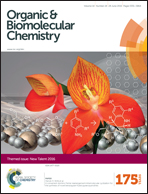Reversible morphological changes of assembled supramolecular amphiphiles triggered by pH-modulated host–guest interactions†
Abstract
Reversible template-directed micellar-size and shape modulation by virtue of host–guest reversible docking of molecular templates at the micellar–solvent interface was achieved in water. By combining a π-electron deficient bipyridinium-based gemini amphiphile which is capable of binding and aligning with a π-electron rich tri(ethylene glycol)-disubstituted 1,5-diaminonaphthalene, a switchable detergent system which operates through the pH-responsive formation of bisammonium dications was realised. The binding of the 1,5-diaminonaphthalene guest to the bipyridinium-based micellar aggregate superstructure can be actuated by the addition of acid and base. Upon the addition of acid, protonation of the guest forming the dication deactivates molecular recognition with the charged head groups of the micellar aggregate by Coulombic repulsion. This process is completely reversible upon the addition of base, whereby the guest reintercalates into the superstructure –again forming donor–acceptor π–π stacks at the micellar–solvent interface amongst contiguous surfactant head groups. Synchrotron small angle X-ray scattering and dynamic laser light scattering confirm that this form of reversible directionally-templated micellisation results in an oblate spheroid-to-lamellar micelle morphological transition with a stabilising net decrease in the free energy of micellisation  of 1.4 kcal mol−1 per hydrophobic tail.
of 1.4 kcal mol−1 per hydrophobic tail.

- This article is part of the themed collection: New Talent

 Please wait while we load your content...
Please wait while we load your content...